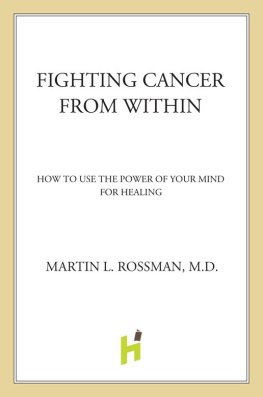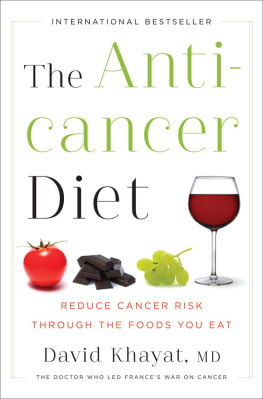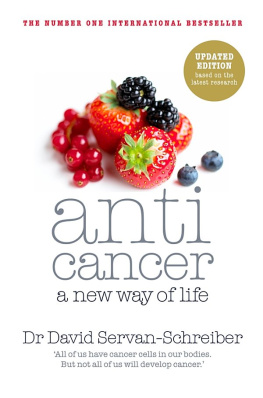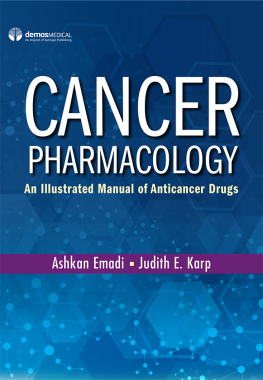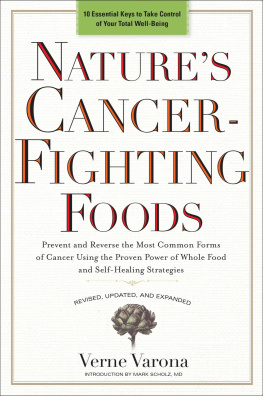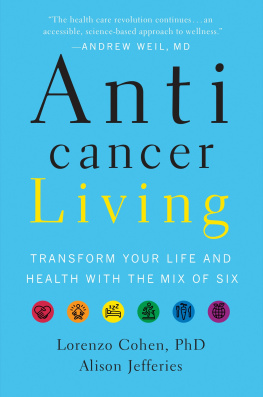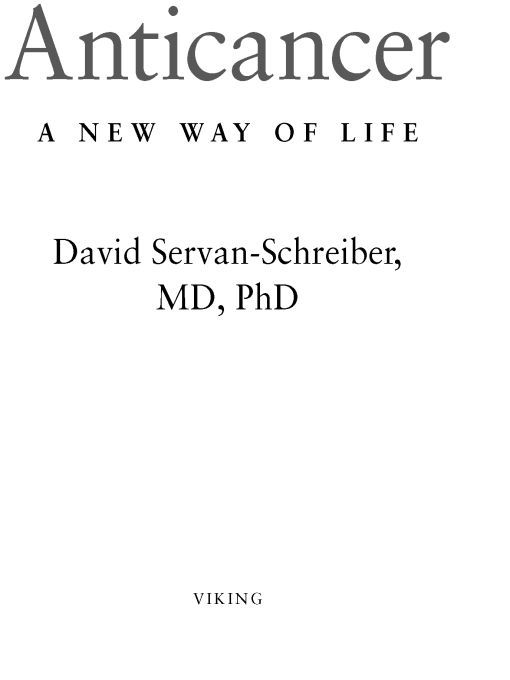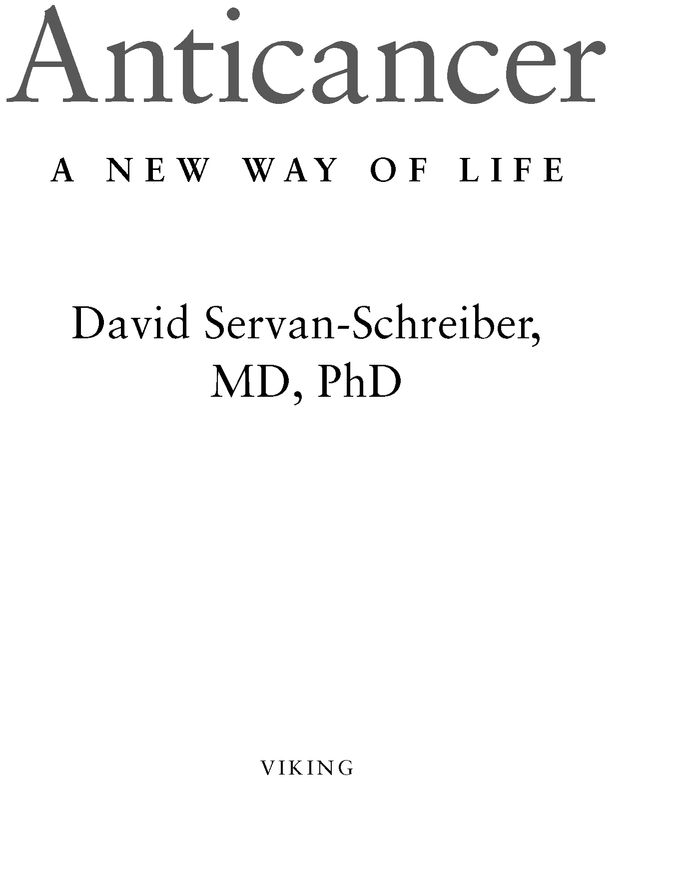Table of Contents
This book is dedicated to:
MY FELLOW PHYSICIANS,
who tirelessly treat suffering and fear, sometimes with a courage as great as their patients. Above all, I hope they will find this book useful and will want, as I did, to integrate these approaches into their practice.
AND MY SON SACHA,
born during this time of upheaval, whose enthusiasm for life is an inspiration to me every day.
Foreword
This book describes natural methods of health care that contribute to preventing the development of cancer or to bolstering its treatment. They are meant to serve as a complement to conventional approaches (such as surgery, radiotherapy, chemotherapy). The contents of this book cannot replace a physicians opinion. It is not intended to be used to make a diagnosis or to recommend a treatment.
All the clinical cases I refer to in the following pages are drawn from my own experience (except for a few cases described by fellow physicians in the medical literature, which are indicated as such). For obvious reasons, patients names and other identifying features have been changed.
I have chosen to set forth our present understanding of cancer and of natural defenses in simple terms. In certain cases, this hasnt allowed me to describe the full complexity of biological phenomena or the details of controversies over existing clinical studies. Though I believe I have been faithful to the spirit of their research, I apologize to biologists and to oncologists for thus simplifying what for many of them represents their lifes work.
I have always felt that the only trouble with scientific medicine is that it is not scientific enough. Modern medicine will become really scientific only when physicians and their patients have learned to manage the forces of the body and the mind that operate via vis medicatrix naturae [the healing power of nature].
REN DUBOS, professor of biology, Rockefeller University;
discoverer of the first antibiotic in clinical use (1939);
founder of the first earth summit (1972)
of the United Nations
Introduction to the Second Edition
Seventeen years ago, I discovered from my own brain-scanning experiment that I had brain cancer. From the waiting room on the tenth floor of the oncology building, I remember looking down at people in the streetdistant and oblivious, going about their everyday life. I had been cast out of that life, separated from its goal-oriented busyness and from its promises of joy, by the prospect of a probable early death. No longer wrapped in the comfortable mantle of physician and scientist, I had become a cancer patient. This book is the story of what happened nextof the return to life and healthin fact, to a level of health I had never experienced beforewhile knowing I had cancer. It is the story of how I used my skills as a physician and a scientist to find out everything in the medical literature that would help me change the odds. Most important, it offers a new, scientifically based perspective on cancer that gives all of us a chance to better protect ourselves from this disease.
The publication of Anticancer two years ago launched a new chapter in my journey. After having kept my illness a secret for fourteen years, I was able to take what I had learned and bring it around the world to people who were frightened, depressed, or had lost hope. I was able to discuss these ideas with doctors, scientists, politicians, and activists and to compare my observations directly with their experiences. I also met a considerable number of patients who had changed the course of their illness with the advice that is given here. After publication in thirty-five languages in close to fifty countries, and after more than a million copies sold, my conviction that we can all powerfully strengthen our bodies natural defenses against cancer has been reaffirmed. As has my belief that this approach should be a part of preventing or treating cancer for everyone. In the past two years, research has also yielded new proofs, explanations, and perspectives on how we can all learn to strengthen our health and improve our terrain by creating an anticancer biology within our body, and it has confirmed the importance of paying attention to how our emotions may affect the course of cancer.
So what exactly is new in this revised edition?
In my many discussions with my medical colleaguesdoctors, oncologists, psychiatristsand with the public, I realized that the books message about nutrition has been much more easily grasped than the analysis of mind-body factors and the crucial role played by the feeling of helplessness in promoting cancer. If there is one single, clear, and emphatic message Id like to send with this revised edition, it is that we must pay close attention to the mind-body connection, especially the negative impact of prolonged feelings of helplessness and despair. When left unattended, these feelingsnot the stresses of life themselvescontribute to the inflammatory processes that can help cancer grow. There are truly effective and simple methods for taming those feelings, experiencing life on a more satisfying level, and reducing inflammation at the same time.
To address this, Ive completely revised chapter 9, The Anticancer Mind, and Ive also updated it with new studies that confirm how important it is to treat feelings of helplessness and despair in order to fight the progression of cancer. I have taken this opportunity to share the story of Kelly, who, in her struggle against breast cancer, was able to rely on friends to give her the support and love she needed to get through her ordeal. Recent studies show, in fact, that its not only the love of a husband, a wife, or children that can enable morale to remain strong and slow the progression of illness, but also the simple love and caring attention of friends old and new.
In terms of nutrition, promising recent studies have attested to a number of new anticancer foods. Large-stoned summer fruit, such as plums and peaches, can now be included in this category. New data about olive oil, which was already strongly recommended in the first edition, now make it a fully fledged anticancer food with activity against a variety of specific cancer types.
Also, two new studies have shown exactly how many cups of green tea need to be drunk per day to reduce the risk of breast or prostate cancer relapse by more than 50 percent. New natural sweetenersacacia honey and coconut sugar, characterized by a low glycemic indexhave appeared on the market alongside agave nectar. These are introduced in chapter 6.
New research has confirmed the importance of vitamin D3 in preventing cancer, particularly in countries where the lack of sunshine means that the skin cannot synthesize enough of this vitamin during the winter. Ive therefore given more attention to this topic, and made new and more specific recommendations.
Finally, information has become available on how different cooking methods may preserve or, to the contrary, reduce the benefits of anticancer foods.
Almost every time I give a lecture, Im asked whether cell phone use can cause cancer. In order to respond to these questions, in 2008 I brought together a group of cancer specialists, toxicologists, epidemiologists, and a physicist. We published an appeal recommending a number of precautions to take for better, safer use of cell phones, as they are now an unavoidable feature of everyday life. The appeal was quickly picked up around the world and even led to a House of Representatives hearing in the United States in September 2008 and a public roundtable organized by the Ministry of the Environment and the Ministry of Health in France in April 2009. This edition summarizes the scientific literature on this subject and reprises the precautions that can be taken toward safer cell phone use.


